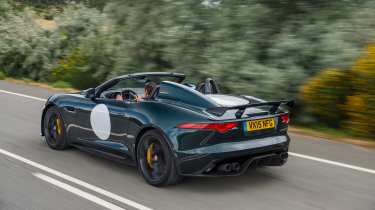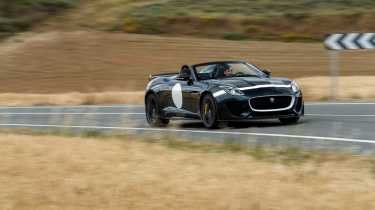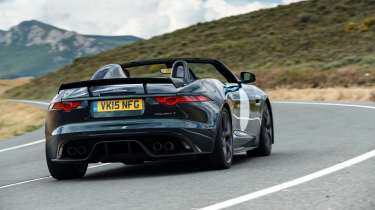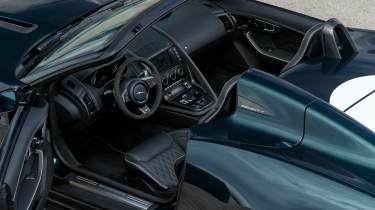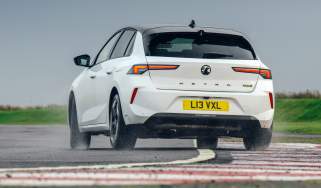Jaguar Project 7 (2015 - 2016) review – the peak of Jaguar's outgoing era?
As Jaguar’s reinvention continues at pace, we look back at the Jaguar Project 7, a star of its bygone era
The Jaguar F-Type Project 7 was arguably the halo model of what is now the marque’s bygone era. Created by JLR’s Special Vehicle Operations department, it’s what happens when demand for a concept convinces a manufacturer to go all the way. As the XKR-S GT and the massively popular Range Rover Sport SVR reached the market, SVO began work on productionising Project 7 from low-windscreened concept car, to homologated (small volume) production car.
Just 250 were built, with 80 reaching the UK. Compared to the struggle Jaguar had selling XE Project 8s, the Project 7 was a huge success, selling out before the car was officially announced.
Jaguar Project 7 technical highlights
Based on an F-Type R convertible, Project 7 was lighter (by 45kg), more powerful (up to 567bhp from 542bhp), had a much more aggressive chassis set-up and was the first F-Type to produce proper downforce, too. Of course the styling called to mind the gorgeous D-Type but this was very clearly more than an F-Type sprinkled with evocative details.
SVO went through pretty much every area of the F-Type R convertible to find more performance and sharper responses. Its 5-litre V8 isn’t hugely different from the one found in the standard R but with a bit more boost from the supercharger, Project 7 produced its 567bhp at 6500rpm and 502lb ft at 2500-5500rpm. It drove through the eight-speed ‘Quickshift’ automatic gearbox but with unique programming for faster shifts. The top speed was 186mph and 0-62mph came up in 3.8sec. Project 7 was the most powerful Jaguar ever before the Project 8 came along, which itself could be dethroned in Jaguar’s coming all-electric era.
More reviews
It’s the chassis and aero where the real work took place. The suspension was heavily revised, with unique suspension knuckles to radically increase front camber (up to 1.5 deg from 0.5), the spring rate was up by 80 per cent at the front, there were upgraded top mounts, the spring platforms were height adjustable and Project 7 also received bespoke anti-roll bars. Carbon-ceramic brakes were standard as part of weight saving measures that also included unique lightweight seats; it weighed 1620kg. The standard 20-inch wheels came equipped with Continental ContiForceContact tyres and Project 7 also used torque-vectoring by braking.
In terms of aero the large front splitter, rear venturi and fixed rear wing combined to reduce drag slightly over an F-Type when the roof was down but massively increased downforce – it was up 177 per cent at 186mph. The updated EPAS system also had a unique calibration, as did the throttle (it was more progressive than the F-Type R). In other words, it was a proper job. As much was confirmed when you considered its 7:35 time around the Nürburgring.
Jaguar Project 7 review
The Project 7 is, as you’d expect, very amusing to drive. This car wasn’t a complete step-change over the F-Type R but the sense of agility, mid-corner grip and traction are all improved, whilst the F-Type’s sense of sheer fun is preserved. Fears that the search for grip and lap time polluting the easily manipulated balance were unfounded. Project 7 turned out to be as exuberant a car as you could hope to find.
It might not have a roof (save for the low-speed emergency item) and it might hark back to race cars such as the D-Type, but Project 7 is very, very easy to drive and amazingly supple. In fact, in its standard set-up the ride is more compliant than the F-Type R of the same age, but there’s a much more noticeable gap when you select Dynamic mode to give the car a more aggressive feel.
Jaguar F-type (2013 - 2019) review – stunning looks and still able to thrill on the road
On smooth roads, Project 7 is at its best in the more aggressive set-up. When new it felt fluid and poised but there’s greater front-end response, the car digging in and biting harder. The chassis also gives even more options. In the F-Type R, you’re either gripping or sliding dramatically into oversteer. That’s fun of course, but Project 7 hangs on much better mid-corner and allows you to shift its balance with more subtlety and greater control. It’s still a natural oversteerer but despite more grip.
This engine was always a mighty, mighty performer and the noise is almost comically OTT. It howls and crackles and booms on the overrun, the swirling air just adding to the sense of occasion. It really was an experience to make you smile. However, there were some disappointments. The F-Type was never a great communicator through the steering.
The EPAS system was accurate but slightly light on feel. Despite the chassis digging in you don’t feel much grit through the steering wheel and so using that extra grip is a matter of learning to trust the car rather than feeling everything that the treadblocks have to give.
Used Jaguar F-Type (2013 - 2024) review and buyer’s guide
On the track the Project 7 impressed up to a point. Greater turn-in agility and mid-corner grip make you feel you can hustle it more without the grip just falling away… but it was still a pretty hefty thing and time-sapping understeer was never out of the question, followed by big oversteer on corner exit. It was no GT3 when new, that’s for sure. Nevertheless, Project 7 was a seriously enjoyable car and only endears more outside of contemporary comparison.
Jaguar Project 7 values and rivals
At £135,000 it was around £40,000 more than an F-Type R at the time of release, for which those lightweight seats and carbon-ceramics came as standard and of course, you got one of just 250 examples to be built. Consider also what this genre of roofless limited special would become and how expensive cars of its ilk would get – Ferrari Monza, Aston Martin V12 Speedster and McLaren Elva, anyone?
At the time we concluded however that the Project 7 could have gone further; More aggression, a more focused set-up. As was, it was certainly no pastiche. We wrote at the time of ‘hope’ that ‘any future F-Type SVR uses Project 7 as inspiration but pushes the car further and showcases SVR’s full potential’. Of course, we now know, the F-Type SVR was a more precise instrument thanks to its AWD, if not the GT3 rival that we’d perhaps hoped for.
Project 7 didn’t have rivals as such – as above it (along with the McLaren-Mercedes SLR Stirling Moss) pre-dated the wave of vastly more expensive limited roofless specials. We compared it to the contemporary AMG GTS and Aston Martin V12 Vantage S Roadster. But in reality, the people who bought it weren’t chosing between one or the other. Project 7 buyers were then and are today, collectors, to which objective comparison does not matter.
Incidentally, around £130-£140k is what you’ll pay for a Project 7 today, which is remarkable value given its scarcity.
| Engine | V8, 5000cc, supercharged |
|---|---|
| Power | 567bhp @ 6500rpm |
| Torque | 502lb ft at 2500-5500rpm |
| 0-62mph | 3.8-seconds |
| Top speed | 186mph |
| Price new | £135k |
| Price now | c£135k |


